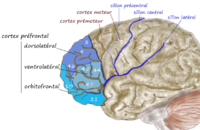
Photo from wikipedia
Retrosplenial cortex (RSC) plays a key role in various cognitive functions. The fiber connectivity of RSC had been reported in rodent and primate studies by tracer injection methods To explore… Click to show full abstract
Retrosplenial cortex (RSC) plays a key role in various cognitive functions. The fiber connectivity of RSC had been reported in rodent and primate studies by tracer injection methods To explore structural and functional connectivity of two sub-regions of RSC, Brodmann area (BA)29 and BA30, we constructed fiber connectivity networks of two sub-regions by diffusion tensor imaging (DTI) tractography based on diffusion magnetic resonance imaging (MRI) and functional connectivity networks by resting-state functional MRI. The BA29 network showed fiber connections with auditory cortex and functional connections with BA21. Both fiber and functional connections show that BA30 network includes visual cortex. Furthermore, BA30 had fiber connections with hippocampus, thalamus, and prefrontal cortex. We suggest that (1) structural connectivity reflects functional connectivity in some degree. (2) BA29 mainly received and processed sound information from auditory cortex, while BA30 mainly received and processed scene information from visual cortex.
Journal Title: Neuroscience Letters
Year Published: 2018
Link to full text (if available)
Share on Social Media: Sign Up to like & get
recommendations!